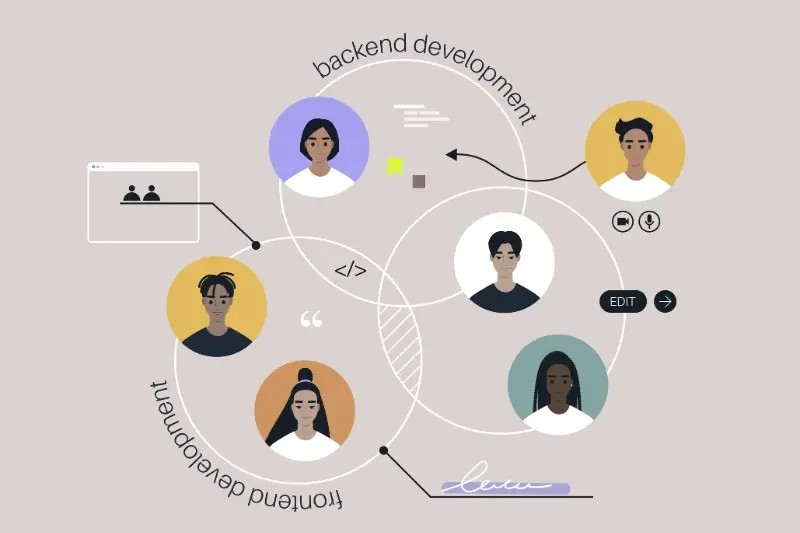7 Things Nobody Tells You About Managing Remote App Developers
A major healthcare app company spent eighteen months building their patient monitoring mobile app with a remote development team spread across four countries. The app launched on schedule and looked fantastic. But within weeks, users were complaining about confusing navigation flows that made no sense to British patients, critical notifications that arrived at 3am because of timezone misconfigurations, and security features that didn't meet local healthcare regulations. The remote team had built exactly what was requested—but nobody had managed the invisible challenges that come with distributed mobile app development.
Managing remote app developers sounds straightforward on paper. You hire talented people, give them clear requirements, set up video calls, and watch the magic happen. That's the theory anyway. The reality of remote team leadership in mobile app development is filled with obstacles that traditional project management books simply don't cover.
Remote development teams can build incredible mobile apps, but only if you understand the hidden challenges that nobody warns you about
After eight years of working with remote development teams on mobile app projects, I've learned that the biggest problems aren't the obvious ones like different time zones or language barriers—though those matter too. The real challenges are much more subtle. They're the things that slowly eat away at your project momentum, team morale, and app quality without you even noticing until it's too late. These hidden challenges can turn what should be a smooth development process into months of frustration, budget overruns, and disappointing results. But here's the good news: once you know what to look for, these problems become much easier to solve.
The Communication Time Zone Trap That Kills Project Momentum
Time zones are probably the biggest silent killer of remote app development projects, yet most people don't realise how much damage they're actually doing until it's too late. You wake up excited to review the latest build, only to find three questions waiting in your inbox that your developer asked six hours ago—and now they've gone to bed. Your simple "yes, that looks good" response won't reach them until tomorrow morning their time.
What seems like a minor delay quickly snowballs into something much bigger. That one day becomes two when your developer needs clarification on your feedback. Then it becomes three days when they implement changes and you're not around to approve them. Before you know it, a task that should have taken 48 hours has stretched into a week.
The Real Cost Goes Beyond Delays
The momentum loss is what really hurts. App development thrives on quick iterations and rapid feedback loops—when you break that rhythm, everything suffers. Your developer loses context switching between projects whilst waiting for responses. You lose enthusiasm when progress feels sluggish. The whole project starts feeling like you're swimming through treacle.
Most project managers try to solve this by scheduling more meetings, but that often makes things worse. You end up with your developer staying late or starting early just to accommodate calls, which leads to burnout and resentment.
Working Smarter With Time Differences
The solution isn't fighting time zones—it's working with them. Set up clear handoff protocols where each person knows exactly what information the other needs to keep moving forward. Record video explanations instead of typing long emails. Use async communication tools that capture context, not just messages. Most importantly, build buffer time into your project timeline that accounts for these natural delays. Time zones will always exist, but good planning means they don't have to derail your project.
When Cultural Differences Become Code Problems
Here's what happens when you're managing a remote mobile app development team across different cultures—what seems like a simple conversation about user interface design can turn into a three-week misunderstanding. I've watched project timelines stretch because a developer in one country interpreted "make it pop" completely differently than what the designer in another country had in mind.
Cultural differences aren't just about language barriers, though those certainly exist. They're about different approaches to problem-solving, varying levels of directness in communication, and completely different expectations about feedback. Some cultures view questioning a decision as disrespectful; others see not questioning it as lazy. When you're building a mobile app with tight deadlines, these differences can create real problems in your code quality and project delivery.
The tricky part is that these issues don't announce themselves. A developer might spend days working on a feature they think you want, when actually you meant something entirely different. By the time you realise what's happened during your next team check-in, you've lost valuable development time and possibly created tensions within your remote team.
Create a shared glossary of terms and visual examples for your mobile app project. What you call a "dropdown menu" might be interpreted as a completely different UI element by someone from a different background.
The solution isn't to avoid cultural diversity—diverse teams build better apps. It's about being more explicit in your communication and creating systems that account for different interpretation styles. Document everything, use visual mockups, and don't assume everyone shares your cultural context when discussing app functionality.
The Hidden Cost of Not Seeing Your Team Work
When you can't physically see your remote app developers working, something strange happens to your brain. You start questioning everything. Are they actually coding right now, or are they watching Netflix? Did that bug fix really take three hours, or did they take a long lunch? It's not that you don't trust them—it's just that the uncertainty starts eating away at you.
The real problem isn't what your developers are doing with their time; it's what this invisible work environment does to your project. Without visual cues, you lose the ability to spot problems early. You can't see when someone's struggling with a tricky bit of code or when they've been staring at the same screen for two hours without making progress.
What You Miss When Work Happens Behind Closed Doors
- Early warning signs that a developer is stuck on a problem
- Natural collaboration opportunities between team members
- The actual complexity of tasks versus your assumptions
- Quality control issues that would be obvious in person
- Team dynamics and communication breakdowns
This invisibility creates a knock-on effect that's expensive. You end up micromanaging through endless check-ins and status updates, which ironically makes your team less productive. Or you go the opposite direction and become too hands-off, only discovering problems when they've already derailed your timeline.
Making Remote Work Visible
The solution isn't trying to spy on your team—that never works. Instead, you need systems that make work naturally visible. Daily standups with screen sharing, regular code reviews, and shared development environments where you can see progress in real-time. Some teams use collaborative coding tools or even occasional pair programming sessions over video calls.
The cost of invisible work isn't just about productivity; it's about the trust and communication that makes great apps possible.
Why Standard Project Management Tools Fall Apart with Remote Teams
Right, let's talk about something that catches most people off guard when managing remote mobile app developers. Those project management tools that worked perfectly when everyone was in the same office? They suddenly feel like they're held together with sticky tape when your team is scattered across different countries.
The problem isn't the tools themselves—it's that they were designed with a fundamentally different working style in mind. When your Android developer is in Ukraine, your iOS specialist is in India, and your designer is in Portugal, those neat little Gantt charts and sprint boards start looking rather optimistic. Tasks that should take two days stretch into a week because someone was waiting for clarification that never came through Slack.
The Notification Nightmare
Most standard tools bombard your team with notifications, which sounds helpful until you realise your developers are either getting pinged at 2am or missing important updates entirely. The ones that do see the notifications often can't respond immediately, so conversations fragment across multiple platforms and time zones.
The biggest mistake teams make is assuming their existing project management approach will just work remotely—it won't, and trying to force it usually makes things worse
What really breaks these systems is the lack of context. When someone marks a task as "blocked" at 6pm their time, the rest of the team won't see it until the next morning—if they check at all. By then, half the team has been spinning their wheels on related work that can't actually be completed. This is where mobile app projects—with their interconnected front-end and back-end dependencies—really suffer from poor remote coordination.
The Skill Gap Reality Check Nobody Talks About
Here's what happens when you hire remote developers: you think you're getting the skills listed on their CV, but sometimes you end up with something quite different. It's not that people are lying—well, most aren't—but there's often a disconnect between what developers think they know and what they actually know.
The problem gets worse when you can't sit next to someone and see how they work. In an office, you'd spot someone struggling with basic tasks pretty quickly. With remote teams, you might not realise there's a skills issue until weeks into the project when deadlines start slipping and code quality becomes questionable.
The Most Common Skill Gaps We See
After working with hundreds of remote developers, certain patterns emerge. Some developers oversell their experience with specific frameworks or tools; others have theoretical knowledge but lack practical application skills. The tricky part is that everyone can talk a good game during interviews.
- Framework knowledge that's more tutorial-deep than production-ready
- Testing skills that sound impressive but fall apart under pressure
- Architecture understanding that works for simple apps but not complex ones
- Problem-solving abilities that rely too heavily on Stack Overflow
- Code review skills that miss obvious security or performance issues
How to Spot the Gaps Early
The solution isn't to become cynical about remote developers—many are brilliant. Instead, build proper technical assessments into your hiring process. Give candidates real problems to solve, not theoretical questions. Ask them to walk you through previous work and explain their decision-making process.
Set up regular code reviews and pair programming sessions early on. Yes, it takes time, but catching skill gaps in week one is much cheaper than discovering them in month three when your launch date is looming. This is especially important when you're hiring mobile app developers who will be working independently for weeks at a time.
Building Trust When You've Never Met Face to Face
Trust is the backbone of any successful mobile app project, but building it with remote developers you've never met creates one of the most underestimated hidden challenges in team leadership. When you can't look someone in the eye, shake their hand, or grab a coffee together, establishing that fundamental connection becomes much harder than most people expect.
The problem isn't just about getting to know your team—it's about creating confidence in their abilities when you have no physical presence to gauge their reactions, work habits, or commitment levels. You're essentially asking yourself to believe in people based on video calls, messages, and code commits alone.
The Trust-Building Tactics That Actually Work
Start with small, low-risk tasks that allow developers to prove themselves without jeopardising your entire project. This isn't about testing them—it's about creating early wins that build confidence on both sides. When someone delivers quality work on time, even for minor features, it establishes a pattern you can rely on.
Transparency becomes your best friend here. Share your concerns openly, ask questions about their process, and don't be afraid to request regular progress updates. Most good developers appreciate clients who communicate clearly about expectations rather than leaving things unsaid.
Set up brief daily check-ins during the first few weeks of any project. These aren't micromanagement sessions—they're trust-building opportunities that help you understand how your remote team operates.
The Documentation That Builds Confidence
Written records become your safety net when working remotely. Keep detailed notes of decisions, changes, and progress. This documentation serves two purposes: it protects everyone involved and shows your developers that you're organised and professional, which encourages them to match that standard.
| Trust-Building Element | Why It Matters | How Often |
|---|---|---|
| Progress Screenshots | Visual proof of development | Daily |
| Code Reviews | Quality assurance and involvement | Weekly |
| Video Calls | Face-to-face connection | Bi-weekly |
| Written Summaries | Clear communication record | After each milestone |
The Burnout Signs You Can't Spot Through a Screen
When your development team is scattered across different countries, spotting burnout becomes much harder than you'd think. The usual office signs—someone looking tired, working late hours, or seeming stressed during meetings—just don't translate well through video calls and project management tools.
Remote developers are brilliant at masking their exhaustion. They'll show up to your weekly check-ins with their camera on, smile politely, and give you all the right answers about project progress. But what you can't see is that they've been working until 2am every night for the past fortnight, or that they're dealing with personal stress that's affecting their code quality.
Warning Signs That Actually Matter
The real indicators of developer burnout in remote teams are much more subtle. You need to look for patterns rather than obvious signals:
- Code commits happening at unusual hours consistently
- Sudden drops in communication or delayed responses to messages
- Increased bugs or technical debt in their recent work
- Short, clipped answers during team meetings
- Missing deadlines they would normally hit easily
- Requesting fewer new features or challenges than usual
Creating Space for Honest Conversations
The solution isn't just better monitoring—it's building a culture where your remote developers feel safe being honest about their workload and mental state. Schedule regular one-on-ones that aren't focused on project updates. Ask direct questions about their wellbeing, not just their task progress.
Most developers won't volunteer that they're struggling, especially when they're worried about job security or letting the team down. Creating multiple touchpoints throughout the week gives you more opportunities to spot the warning signs before burnout becomes a bigger problem for everyone involved. This is particularly crucial when you consider the challenges of remote work environments that many companies are still learning to navigate.
Conclusion
Managing remote app developers isn't just about finding good talent and hoping for the best—it's about understanding that the hidden challenges will test your team leadership skills in ways you never expected. The mobile app development process becomes infinitely more complex when your team is scattered across different time zones, cultures, and working styles.
These seven challenges we've covered aren't meant to scare you away from building remote development teams. They're meant to prepare you for what's actually coming. Because here's the thing—every successful remote team leader has faced these exact same problems. The difference is they learned to spot them early and adapt their approach accordingly.
The communication breakdowns, cultural misunderstandings, and trust-building struggles aren't signs of failure; they're part of the territory. What matters is how quickly you recognise them and adjust your strategy. Some days you'll feel like you're managing blind, trying to keep momentum going whilst juggling different expectations and working styles—and that's completely normal.
Building great mobile apps with remote teams is absolutely possible, but it requires a different kind of leadership than most people expect. You need to be part project manager, part cultural translator, and part detective. You'll develop instincts for reading between the lines of messages and spotting problems before they derail your project.
The truth is, once you master these hidden challenges, managing remote app developers becomes one of the most rewarding ways to build software. You just need to know what you're really signing up for.
Share this
Subscribe To Our Blog
You May Also Like
These Related Stories

How To Build Trust With Your Remote App Development Team

7 Proven Strategies for Handling Mobile App Support Requests





